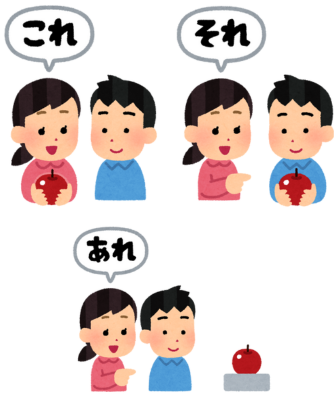
Introduction
In Japanese, just like in English, we have words for “this” and “that.” These words help us point out things and talk about where they are. In Japanese, these words are kore (これ), sore (それ), and are (あれ). Let’s learn what they mean and when to use them!
What It Means
Here’s what these Japanese words mean:
- Kore (これ) means “this” and refers to things that are close to the speaker.
- Sore (それ) means “that” and points to things that are close to the listener.
- Are (あれ) means “that over there” and is used for things that are far from both the speaker and the listener.
When You Use It
Choose which word to use depending on the location of the item you’re discussing:
- Use “kore (これ)” when the item is right next to you, the speaker.
- Use “sore (それ)” when the item is closer to the listener—the person you’re talking to—than it is to you.
- Use “are (あれ)” when the item is far from both you, the speaker, and the listener.

Examples
Here are some simple examples to show you how to use kore, sore, and are:
- これはペンですか。 (Kore wa pen desu ka?) Is this a pen?
– Here, the speaker is likely holding a pen or indicating a pen very close to them. - それはかばんですか。 (Sore wa kaban desu ka?) Is that a bag?
– Here, the speaker is asking about a bag that is closer to the listener than to the speaker. - あれは何ですか。 (Are wa nan desu ka?) What is that over there?
– Here, something that is clearly away from both the speaker and listener, perhaps pointed at in the distance.
Note
In English, we use “this” and “that.” But in Japanese, there are three words: kore (this), sore (that), and are (that over there). The choice between the two types of “that” (sore and are) depends on the location of the people involved in the conversation.
Conclusion
Kore, sore, and are are like “this,” “that,” and “that over there” in English. They help you talk about where things are. As you continue to practice using these words in everyday conversations, you’ll find it easier to navigate and understand Japanese.



